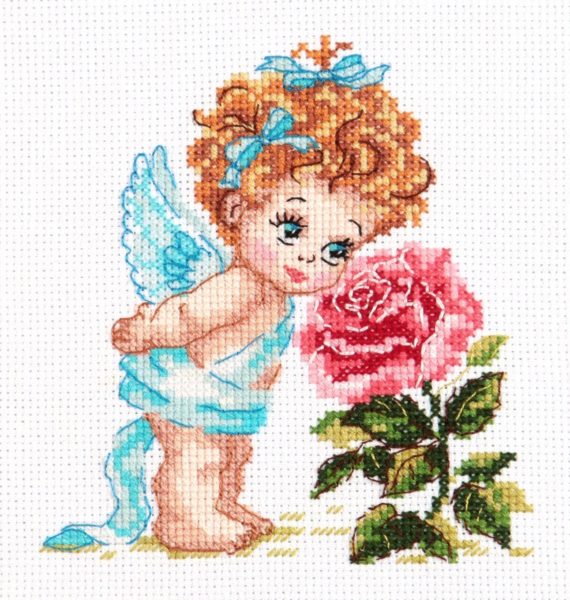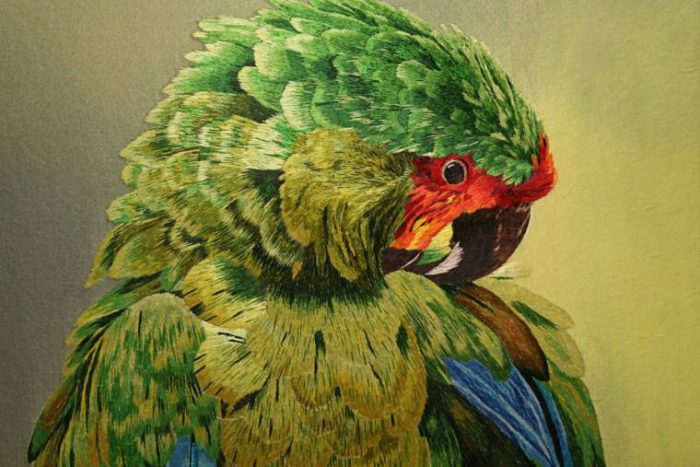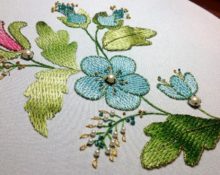Embroidery is one of the oldest types of needlework, the cradle of which is considered to be the East.
With the development of civilization, people paid more and more attention to their appearance, clothing and accessories. The skill was honed from century to century, and after some time, primitive stitches turned into a true work of art.

Types of thread embroidery on fabric
Embroidery methods are distinguished by their diversity. A variety of seam options, used both individually and in various combinations, allow you to create masterpieces that are elegant and original.
Cross

One of the most ancient and widely used types of embroidery, which is an original way of creating a design on canvas using a needle and embroidery thread, and has many applications. Stitches in this technique should always be laid in the same direction.

Surface

A style in which stitches are applied to fabric, completely filling the surface of the fabric.Satin embroidery helps to convey the texture of the design and smooth color transitions. There are different options for satin stitch:
- satin surface - oblique stitches are made quite tightly, each new one is made by sticking a needle under the thread of the previous one and stepping back half its length;
- flat surface — stitches are made sequentially parallel to one another along the entire length of the border of the design (the embroidery is double-sided);
- smooth surface with flooring — first, the backing is made with a thick thread, then it is covered with stitches made with a working thread across the stitches of the backing;
- white surface - small, identical stitches pressed closely together, made with white thread in one direction;
- artistic surface - performed with stitches of various lengths with partial overlap on the previous row;
- Russian surface - done with stitches 5–7 mm long (small gaps remain between the threads, which are closed during the reverse stroke);
- Chinese smooth surface - characterized by maintaining clear boundaries between different colors.

Gold

This is a technique for creating a pattern on canvas with a stitch in the attachment, made with linen or silk threads, tightly entwined with a narrow silver or golden strip, or threads in the form of thin wire made of precious metals.
In ancient times in Rus', this technique was called gold embroidery.

String graphics

For this technique, instead of fabric, velvet or any other fairly thick paper is used. The advantage of this technique is that it is performed quickly and quite accurately the first time.
Using this technique you can effectively decorate any card.

Assisi

Spectacular ancient embroidery, which takes its name from the Italian city of Assisi, where, according to legend, it first appeared (at the beginning of the 13th century). The pattern on the fabric in this technique is created from areas of the background that are not filled with stitches. According to the classical method, the embroidery process took place in 2 stages:
- first, the selected plot was applied to the fabric;
- then the background was sewn up, while the design itself remained untouched.
Embroidery using the Assisi technique is done primarily with a cross stitch.

Silk threads

Embroidery with such threads turns out incredibly bright, smooth and shiny. This is traditionally oriental art. The silk thread is divided into 16 thin threads, which allows you to adjust the thickness of the thread. This makes it possible to change the density of the image, achieving both transparency and three-dimensionality of the image. Since silk thread is too delicate and thin, silk is embroidered exclusively by hand.

Biscornu

A rather voluminous embroidered product of a relatively small size, made from two square fragments of canvas, rotated 90 degrees relative to each other and sewn in such a way that the vertices of one square are aligned with the midpoints of the sides of the second. As a rule, it is used as an accessory (pendant, pincushion, pendant).

Blackwork

An ancient method of embroidery that appeared in the XV–XVI centuries. It is made on a contrasting base with a single black thread using “back needle” or Holbein (“double basting”) seams. Initially, similar embroidery (geometric patterns) was used to decorate clothes (mainly sleeves), as well as tapestries, pillows and furniture covers.

Backstitch

The style of embroidery using this stitch is bright and clear.Using such a seam, you can either create a separate pattern or give clear outlines to an already completed pattern. Many needlewomen call this seam “back needle.”

Satin roller

Such rollers act as fastening stitches made on four threads of fabric on either side of the strip of pulled threads. The stitches enclose the threads of the fabric to allow them to be cut and are placed close together, all in the same direction. You should not switch to a new thread if the roller is not yet finished.

Embroidery needles
To ensure that the embroidery result fully meets your expectations, it is extremely important to choose the right needle. An incorrectly selected needle will significantly complicate the work and will not have the best effect on the final result. A needle that is too thin will cause splitting and rapid thinning of the floss threads, while a needle that is too thick will excessively increase the distance between the threads of the canvas and leave unsightly holes.

For cross stitch, tapestry needles with a blunt point and a long eye are considered an excellent choice. To create satin stitch patterns on thick fabric, sharp sewing needles with a miniature eye are suitable.
The closer the weave of the canvas, the thinner the needle it is recommended to choose.
Embroidery helps not only to preserve the culture and traditions of past times, but also to convey to contemporaries the artistic passions of talented needlewomen of past years.


 0
0





